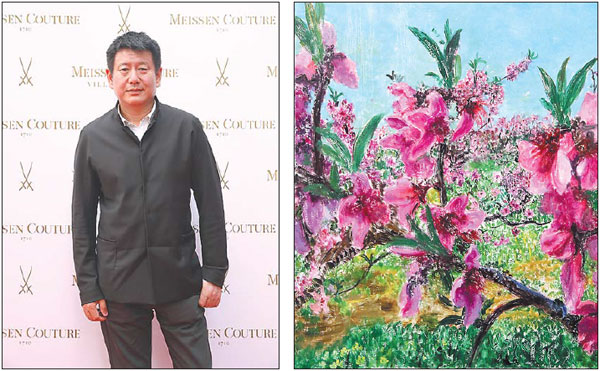Breaking the mold in Shanghai
Updated: 2015-05-29 08:24
By Zhang Kun in Shanghai(China Daily Europe)
|
|||||||||||
Traditional German porcelain firm works with famous Chinese artist for modern twist
A German porcelain maker with a 300-year history has opened its largest shop in the Xujiahui area of Shanghai, and is teaming up with a famous Chinese painter to enrich its product designs.
Meissen Couture Shanghai Villa celebrated its grand opening on May 16. The villa is a three-story building on Hengshan Road with a total floor space of more than 800 square meters, larger than any of the company's retail spaces around the world.
|
Meissen Couture Shanghai Villa opened its doors on May 16. Photos provided to China Daily |
|
Chinese artist Zhou Chunya and his work Blooming. |
The company has expanded its product line to furniture and fashion to bring the brand into the 21st century, officials say.
Its first initiative in Shanghai was to join forces with Zhou Chunya, a renowned Chinese painter. Zhou's work is among the most expensive of any Chinese artist alive. His paintings earned a total of 470 million yuan ($76 million; 68 million euros) at auction in 2013.
Zhou will work with Meissen to create porcelain paintings, sculptures and launch a homeware limited edition.
"I will visit the Meissen production center and learn about their working procedures," Zhou says. "I am sure we will come up with some wonderful ideas to create good work."
Meissen Couture has not announced any of the prices of its items on display. The firm claims it is not just a luxury brand, but a promoter of a "royal lifestyle".
"We were founded by a king," says Ingo Bade, the Asia Pacific head of the company.
Meissen is a town near Dresden, Germany. King Augustus II of Poland lived there more than 300 years ago.
At that time, porcelain was imported into Europe from China, and was viewed as a symbol of fine living. An alchemist, kept in protective custody by the king, developed the method of making porcelain using very high temperatures, a breakthrough that had eluded European potters. It was the king who established the first Meissen factory. Production started at the Albrechtsburg castle in 1710.
Meissen porcelain was the first hard-paste porcelain in Europe and remains one of the most famous porcelain manufacturers today. Its signature logo of two crossed swords is one of the oldest trademarks in existence.
Meissen has amassed 700,000 molds, more than 60,000 designs and tens of thousands of colors in its archives over the centuries. These original artifacts have survived 11 wars and seven political systems. "We don't have any competitors," says Bade.
The original molds and designs are adapted to produce limited editions of new pieces.
The company has more than 250 painters in Meissen. The painters must go through a long period of training and apprenticeship. Many painters work with the state-owned company throughout their career.
Despite its traditional values, the company has decided to branch out, adding its name to other products.
"We don't want to only stick to the past," Bade tells China Daily. "We adapt, like our furniture. With its quality and design, it fits in every household.
"Even if you have a loft, a small apartment, as in Hong Kong, Singapore and Shanghai, you can put our furniture in it."
At the Meissen Couture Shanghai Villa, on a carpet that features patterns from the original Albrechtsburg castle flooring, sits a large table set for eight or more diners, as well as small armchairs and a coffee table that would easily fit into a compact apartment.
"If you want it smaller, you tell us, we will make it especially for you, though the delivery time will be slightly different," Bade says.
Visitors must make an appointment at the Shanghai villa, says company CEO Tillmann Blaschke, to ensure guests have a "royal-like lifestyle experience", with a "private butler" to give you one-on-one shopping guidance. In addition, a cafe for VIPs is located on the second floor of the villa.
Zhou, the artist, studied in Germany in the 1980s. At a time when art in China still was largely driven by ideology and politics, Zhou learned in Germany of the vital importance of an artist being guided by his or her individuality.
"I see in Meissen china deep traditions of German art. The ways they painted floral patterns, the colors they use, for example, are quite unique and different from Chinese ceramics.
"I believe Meissen has chosen me to be the first Chinese artist to work with them because they would like to combine Chinese aesthetics, especially contemporary Chinese aesthetics, with its glorious tradition," he said.
People in China are very aware of the fine technology, chemicals and machinery from Germany, says Peter Rothen, Germany's consul general in Shanghai.
But he says he has been baffled when he walks down the streets of downtown Shanghai, asking himself, "Why aren't there more German products?"
Company officials say Meissen's new villa in Shanghai has helped to remedy that, at least in part.
zhangkun@chinadaily.com.cn
(China Daily European Weekly 05/29/2015 page26)
Today's Top News
British Queen makes references to China in keynote speech
Bayern cashes in on Chinese fans' frenzy for European soccer
German rail giant mulls buying trains from China
Blair to resign as Middle East Quartet envoy
London stock exchange takes steps to include China A shares
China calls for durable settlement of Kosovo issue
China urges BRICS to unite for promoting multi-lateralism
New way to enjoy movie in Berlin
Hot Topics
Lunar probe , China growth forecasts, Emission rules get tougher, China seen through 'colored lens', International board,
Editor's Picks

|

|

|

|

|

|








